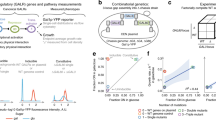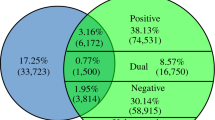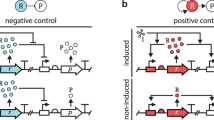Abstract
Changes in gene regulatory networks are a major source of evolutionary novelty1,2,3. Here we describe a specific type of network rewiring event, one that intercalates a new level of transcriptional control into an ancient circuit. We deduce that, over evolutionary time, the direct ancestral connections between a regulator and its target genes were broken and replaced by indirect connections, preserving the overall logic of the ancestral circuit but producing a new behaviour. The example was uncovered through a series of experiments in three ascomycete yeasts: the bakers’ yeast Saccharomyces cerevisiae, the dairy yeast Kluyveromyces lactis and the human pathogen Candida albicans. All three species have three cell types: two mating-competent cell forms (a and α) and the product of their mating (a/α), which is mating-incompetent. In the ancestral mating circuit, two homeodomain proteins, Mata1 and Matα2, form a heterodimer that directly represses four genes that are expressed only in a and α cells and are required for mating4,5,6. In a relatively recent ancestor of K. lactis, a reorganization occurred. The Mata1–Matα2 heterodimer represses the same four genes (known as the core haploid-specific genes) but now does so indirectly through an intermediate regulatory protein, Rme1. The overall logic of the ancestral circuit is preserved (haploid-specific genes ON in a and α cells and OFF in a/α cells), but a new phenotype was produced by the rewiring: unlike S. cerevisiae and C. albicans, K. lactis integrates nutritional signals, by means of Rme1, into the decision of whether or not to mate.
This is a preview of subscription content, access via your institution
Access options
Subscribe to this journal
Receive 51 print issues and online access
$199.00 per year
only $3.90 per issue
Buy this article
- Purchase on Springer Link
- Instant access to full article PDF
Prices may be subject to local taxes which are calculated during checkout




Similar content being viewed by others
References
Carroll, S. Evo-devo and an expanding evolutionary synthesis: a genetic theory of morphological evolution. Cell 134, 25–36 (2008)
Davidson, E. H. & Erwin, D. H. Gene regulatory networks and the evolution of animal body plans. Science 311, 796–800 (2006)
Wray, G. A. The evolutionary significance of cis-regulatory mutations. Nature Rev. Genet. 8, 206–216 (2007)
Galgoczy, D. J. et al. Genomic dissection of the cell-type-specification circuit in Saccharomyces cerevisiae . Proc. Natl Acad. Sci. USA 101, 18069–18074 (2004)
Tsong, A. E., Miller, M. G., Raisner, R. M. & Johnson, A. D. Evolution of a combinatorial transcriptional circuit: a case study in yeasts. Cell 115, 389–399 (2003)
Srikantha, T. et al. TOS9 regulates white-opaque switching in Candida albicans . Eukaryot. Cell 5, 1674–1687 (2006)
Herskowitz, I. A regulatory hierarchy for cell specialization in yeast. Nature 342, 749–757 (1989)
Barsoum, E., Sjöstrand, J. O. O. & Aström, S. U. Ume6 is required for the MATa/MATα-cellular identity and transcriptional silencing in Kluyveromyces lactis . Genetics 184, 999–1011 (2010)
Herskowitz, I. MAP kinase pathways in yeast: for mating and more. Cell 80, 187–197 (1995)
Dignard, D., André, D. & Whiteway, M. Heterotrimeric G-protein subunit function in Candida albicans: both the α and β subunits of the pheromone response G protein are required for mating. Eukaryot. Cell 7, 1591–1599 (2008)
Coria, R. et al. The pheromone response pathway of Kluyveromyces lactis . FEMS Yeast Res. 6, 336–344 (2006)
Chang, F. & Herskowitz, I. Identification of a gene necessary for cell cycle arrest by a negative growth factor of yeast: FAR1 is an inhibitor of a G1 cyclin, CLN2. Cell 63, 999–1011 (1990)
Butty, A. C., Pryciak, P. M., Huang, L. S., Herskowitz, I. & Peter, M. The role of Far1p in linking the heterotrimeric G protein to polarity establishment proteins during yeast mating. Science 282, 1511–1516 (1998)
Côte, P. & Whiteway, M. The role of Candida albicans FAR1 in regulation of pheromone-mediated mating, gene expression and cell cycle arrest. Mol. Microbiol. 68, 392–404 (2008)
Bailey, T. L. & Elkan, C. Fitting a mixture model by expectation maximization to discover motifs in biopolymers. Proc. Int. Conf. Intell. Syst. Mol. Biol. 2, 28–36 (1994)
Goutte, C. & Johnson, A. D. Recognition of a DNA operator by a dimer composed of two different homeodomain proteins. EMBO J. 13, 1434–1442 (1994)
Hull, C. M. & Johnson, A. D. Identification of a mating type-like locus in the asexual pathogenic yeast Candida albicans . Science 285, 1271–1275 (1999)
Covitz, P. A. & Mitchell, A. P. Repression by the yeast meiotic inhibitor RME1. Genes Dev. 7, 1598–1608 (1993)
Toone, W. M. et al. Rme1, a negative regulator of meiosis, is also a positive activator of G1 cyclin gene expression. EMBO J. 14, 5824–5832 (1995)
Barsoum, E., Martinez, P. & Astrom, S. U. α3, a transposable element that promotes host sexual reproduction. Genes Dev. 24, 33–44 (2010)
Kassir, Y. & Simchen, G. Regulation of mating and meiosis in yeast by the mating-type region. Genetics 82, 187–206 (1976)
Mitchell, A. P. & Herskowitz, I. Activation of meiosis and sporulation by repression of the RME1 product in yeast. Nature 319, 738–742 (1986)
Hickman, M. A. & Rusche, L. N. The Sir2-Sum1 complex represses transcription using both promoter-specific and long-range mechanisms to regulate cell identity and sexual cycle in the yeast Kluyveromyces lactis . PLoS Genet. 5, e1000710 (2009)
Herman, A. Interspecies sex-specific growth responses in Kluyveromyces . Antonie van Leeuwenhoek 36, 421–425 (1970)
Tuch, B. B., Galgoczy, D. J., Hernday, A. D., Li, H. & Johnson, A. D. The evolution of combinatorial gene regulation in fungi. PLoS Biol. 6, e38 (2008)
Kurtzman, C. P. & Fell, J. W. The Yeasts: A Taxonomic Study 4th edn (Elsevier, 2000)
Ezov, T. K. et al. Molecular-genetic biodiversity in a natural population of the yeast Saccharomyces cerevisiae from ‘Evolution Canyon’: microsatellite polymorphism, ploidy and controversial sexual status. Genetics 174, 1455–1468 (2006)
Gehring, W. J. & Ikeo, K. Pax 6: mastering eye morphogenesis and eye evolution Trends Genet . 15, 371–377 (1999)
Nobile, C. J. et al. Biofilm matrix regulation by Candida albicans Zap1. PLoS Biol. 7, e1000133 (2009)
Homann, O. R. & Johnson, A. D. MochiView: versatile software for genome browsing and DNA motif analysis. BMC Biol. 8, 49 (2010)
Sherman, F. Getting started with yeast. Methods Enzymol. 350, 3–41 (2002)
Wach, A. PCR-synthesis of marker cassettes with long flanking homology regions for gene disruptions in S. cerevisiae . Yeast 12, 259–265 (1996)
Longtine, M. S. et al. Additional modules for versatile and economical PCR-based gene deletion and modification in Saccharomyces cerevisiae . Yeast 14, 953–961 (1998)
Janke, C. et al. A versatile toolbox for PCR-based tagging of yeast genes: new fluorescent proteins, more markers and promoter substitution cassettes. Yeast 21, 947–962 (2004)
Wolf, K., Breunig, K. & Barth, G. Non-Conventional Yeasts in Genetics, Biochemistry and Biotechnology (Springer, 2003)
Gojkovic, Z., Jahnke, K., Schnackerz, K. D. & Piskur, J. PYD2 encodes 5,6-dihydropyrimidine amidohydrolase, which participates in a novel fungal catabolic pathway. J. Mol. Biol. 295, 1073–1087 (2000)
Janbon, G., Sherman, F. & Rustchenko, E. Monosomy of a specific chromosome determines L-sorbose utilization: a novel regulatory mechanism in Candida albicans . Proc. Natl Acad. Sci. USA 95, 5150–5155 (1998)
Mitrovich, Q. M., Tuch, B. B., Guthrie, C. & Johnson, A. D. Computational and experimental approaches double the number of known introns in the pathogenic yeast Candida albicans . Genome Res. 17, 492–502 (2007)
Rouillard, J.-M., Zuker, M. & Gulari, E. OligoArray 2.0: design of oligonucleotide probes for DNA microarrays using a thermodynamic approach. Nucleic Acids Res. 31, 3057–3062 (2003)
Lemoine, S., Combes, F., Servant, N. & Le Crom, S. Goulphar: rapid access and expertise for standard two-color microarray normalization methods. BMC Bioinformatics 7, 467 (2006)
de Hoon, M. J., Imoto, S., Nolan, J. & Miyano, S. Open source clustering software. Bioinformatics 20, 1453–1454 (2004)
Saldanha, A. J. Java Treeview—extensible visualization of microarray data. Bioinformatics 20, 3246–3248 (2004)
Bennett, R. J., Uhl, M. A., Miller, M. G. & Johnson, A. D. Identification and characterization of a Candida albicans mating pheromone. Mol. Cell. Biol. 23, 8189–8201 (2003)
Acknowledgements
We thank Q. Mitrovich, O. Homann, A. Hernday, M. Miller, C. Cain, T. Sorrells and H. Madhani for helpful discussions and technical contributions; and S. Åström for generously providing the K. lactis strains used in this study. The S. cerevisiae strains were a gift from the H. Madhani and J. Li laboratories. The work was funded by grant RO1 GM037049 from the National Institutes of Health. L.N.B. is a National Science Foundation Graduate Research Fellow.
Author information
Authors and Affiliations
Contributions
L.N.B. performed all experiments. L.N.B. and B.B.T. analysed data. L.N.B., B.B.T. and A.D.J. designed the study and wrote the paper.
Corresponding author
Ethics declarations
Competing interests
The authors declare no competing financial interests.
Supplementary information
Supplementary Information
The file contains Supplementary Figures 1-2 with legends, Supplementary Tables and additional references. (PDF 344 kb)
Rights and permissions
About this article
Cite this article
Booth, L., Tuch, B. & Johnson, A. Intercalation of a new tier of transcription regulation into an ancient circuit. Nature 468, 959–963 (2010). https://doi.org/10.1038/nature09560
Received:
Accepted:
Published:
Issue Date:
DOI: https://doi.org/10.1038/nature09560
This article is cited by
-
A conserved regulator controls asexual sporulation in the fungal pathogen Candida albicans
Nature Communications (2020)
-
Regulation of mating type switching by the mating type genes and RME1 in Ogataea polymorpha
Scientific Reports (2017)
-
Intersecting transcription networks constrain gene regulatory evolution
Nature (2015)
-
Prevalence of transcription factors in ascomycete and basidiomycete fungi
BMC Genomics (2014)
-
Convergent evolution of a fused sexual cycle promotes the haploid lifestyle
Nature (2014)
Comments
By submitting a comment you agree to abide by our Terms and Community Guidelines. If you find something abusive or that does not comply with our terms or guidelines please flag it as inappropriate.



